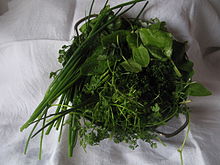Fresh herb composition "Frankfurt Green Sauce"

The fresh herb composition "Frankfurter Green Sauce" or "Frankfurter Grie Soß" is a special mixture of fresh kitchen herbs from the greater Frankfurt am Main area , which serves as the basis for various variable dishes and especially for the traditional preparation of the cold sauce of the same name, Frankfurter Green Sauce ( green sauce for short ) is used. The name is a protected geographical indication (PGI) under European law.
Components and EU quality mark
The EU quality mark "Protected Geographical Indication (PGI)" was awarded to the fresh herb composition by the European Union on March 9, 2016; the detailed application with the product specification was published in October 2015.
The special herbal mixture consists of fresh leaves, leaf stalks and shoot tips of seven different culinary herbs of the following types: borage , chervil , cress , parsley , pimpinelle , sorrel and chives . The composition of the seven individual cut herb components as well as the creation of the container rolls must be done exclusively by hand in the area of origin.

The geographic area is formed by the city of Frankfurt am Main and the directly adjacent cities and communities:
- Groß-Gerau district : Kelsterbach , Mörfelden-Walldorf , Rüsselsheim am Main , Raunheim ,
- Hochtaunuskreis : Bad Homburg vor der Höhe , Oberursel , Steinbach (Taunus)
- Main-Kinzig-Kreis : Maintal , Niederdorfelden
- Main-Taunus-Kreis : Eschborn , Hattersheim am Main , Hofheim am Taunus , Kelkheim , Kriftel , Liederbach am Taunus , Schwalbach am Taunus , Sulzbach (Taunus)
- Offenbach district : Neu-Isenburg
- Wetteraukreis : Bad Vilbel , Karben
- Offenbach am Main
The herbal package “Frankfurter Grüne Soße” / “Frankfurter Grie Soß” (PGI) should contain the seven herbs mentioned that must be grown in Frankfurt am Main or near the city limits. The weight proportions of the individual herbs are regulated, no type of herb may be represented with more than 30 percent in the special "herb rolls". Traditionally, some of these herbs, such as pimpinelle, are rarely found outside of Frankfurt.
use
The special fresh herb composition is mainly used for the traditional preparation of Frankfurt Green Sauce , which is used as a cold sauce in various dishes. Frankfurter semolina sauce with hard-boiled eggs and boiled potatoes is known as a seasonal main course . In the upscale Frankfurt kitchen the sauce as a side dish with cooked brisket of beef , boiled beef or fish served. In addition, since the 1990s there has been a dish known as Frankfurter Schnitzel on some menus , which is a Wiener-style schnitzel with fried potatoes and green sauce.
The herbal composition is also used in the preparation of the classic Frankfurt Sauce ( French: Sauce Francfort , also Green Sauce ), a cold sauce similar to a mayonnaise . It is served as an accompaniment to cold roasts , soup meat or baked fish.
literature
- Geographical indications of origin (Regulation (EU) No. 1151/2012): 30599020.9 Frankfurter Grüne Soße / Frankfurter Grie Soß. In: register.dpma.de. German Patent and Trademark Office . 2008–2016, accessed April 30, 2019 (list of publications, downloads).
- Part 7e) Version of the product specification to which the decision of the European Commission in accordance with Art. 50 Paragraph 2 of the Regulation refers. "Frankfurter Green Sauce" / "Frankfurter Grie Soß" . In: German Patent and Trademark Office (ed.): DE Markenblatt . Issue 34, August 21, 2015, part 7, p. 18398–18400 ( full text on register.dpma.de [PDF; 46 kB ; accessed on April 30, 2019]).
- Publication of an application for registration […] (2015 / C 350/13) - Council Regulation (EC) No. 510/2006 on the protection of geographical indications and designations of origin for agricultural products and foodstuffs "Frankfurter Grüne Soße" / "Frankfurter Grie Soß" EG- No .: DE-PGI-0005-0884-13.7.2011 PGI In: European Commission (Ed.): Official Journal of the European Union . October 22, 2015, p. C 350/10 – C 350/13 ( full text on eur-lex.europa.eu [PDF; 410 kB ; accessed on April 30, 2019]).
Web links
- EU Commission Bonn: Frankfurt green sauce protected throughout the EU. In: ec.europa.eu. European Commission , March 9, 2016 .
- (dpa): The "green sauce" is better protected. In: FAZ.net . March 9, 2016 .
Individual evidence
- ↑ Entry on Frankfurter Grüne Soße / Frankfurter Grie Soß in the Database of Origin and Registration (DOOR) of the General Directorate for Agriculture and Rural Development of the European Commission .
- ↑ a b c d Publication 2015 / C 350/13 (PDF) In: Official Journal of the European Union of October 22, 2015, accessed on May 3, 2019.
- ↑ EU Commission Bonn: Frankfurt green sauce protected throughout the EU. In: ec.europa.eu. European Commission , March 9, 2016, accessed February 14, 2020 .
- ↑ Norbert Brieke: delicacies from Frankfurt and dining. Waldemar Kramer Verlag, Frankfurt am Main 1991, ISBN 3-7829-0409-5 , p. 139.
- ↑ F. Jürgen Herrmann (Ed.): Herings Lexicon of the Kitchen . 25th, revised edition. Specialized book publisher Dr. Pfanneberg, & Co., Gießen 2012, ISBN 978-3-86820-344-8 , p. 60.
- ↑ Erhard Gorys : The new kitchen dictionary . dtv, Munich 1994-2002, ISBN 3-423-36245-6 , p. 167.